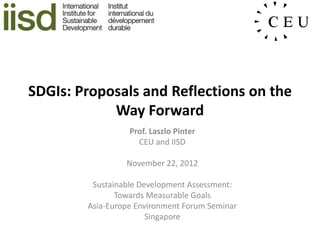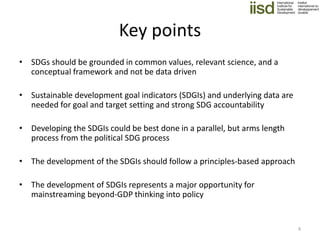02 laszlo singapore sdg_is
- 1. SDGIs: Proposals and Reflections on the Way Forward Prof. Laszlo Pinter CEU and IISD November 22, 2012 Sustainable Development Assessment: Towards Measurable Goals Asia-Europe Environment Forum Seminar Singapore
- 2. 2
- 3. âWe need many indicators because we have many different purposesâbut there may be over-arching purposes that transcend nations and cultures, and therefore there may be overarching indicators.â (Donella H. Meadows, 1998) 3
- 4. Key points âĒ SDGs should be grounded in common values, relevant science, and a conceptual framework and not be data driven âĒ Sustainable development goal indicators (SDGIs) and underlying data are needed for goal and target setting and strong SDG accountability âĒ Developing the SDGIs could be best done in a parallel, but arms length process from the political SDG process âĒ The development of the SDGIs should follow a principles-based approach âĒ The development of SDGIs represents a major opportunity for mainstreaming beyond-GDP thinking into policy 4
- 5. The identification of SDGs should not be data driven, but grounded in common values, relevant science, and a conceptual framework that represents key domains of sustainable development and interlinkages between the domains. 5
- 6. Source: Pinter, L., K. Zahedi and D. Cressman. (2000) Capacity Building for Integrated Environmental Assessment and Reporting. Nairobi: UNEP and IISD. 6
- 7. Sustainable development goal indicators (SDGIs) should inform goal and target setting and serve as an important element of the SDGsâ governance and accountability mechanism. 7
- 8. In order to ensure scientific credibility, objectivity, and timely access to relevant facts and evidence in the political SDG process, a parallel but arms-length institutional arrangement and process should be set up from the beginning for the development of the SDGIs. The political SDG and technical SDGI processes should work iteratively and in close coordination. 8
- 9. The development of the SDGIs should follow a principles-based approach, such as the Bellagio Sustainability Assessment and Measurement Principles or BellagioSTAMP developed in a multistakeholder process coordinated by the OECD and IISD. 9
- 10. BellagioSTAMP 1. Guiding vision 2. Essential considerations 3. Adequate scope 4. Framework and indicators 5. Transparency 6. Effective communication 7. Broad participation 8. Continuity and capacity 10
- 11. The development of SDGIs represents a major opportunity for mainstreaming results of the ongoing review of the system of national accounts, including the development of a new framework for environmental statistics and sustainability indicators into policy. 11
- 12. Post-2015 Development Agenda Planning Implementation MDGs and Sustainable Development Goals MDGIs Sustainable Development Goal Monitoring and Indicators Beyond GDP and SNA reform 2012 2015
- 13. 13













